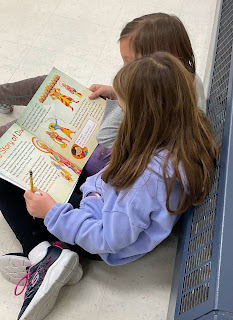Post #6
December 5-9
Making Connections To Text
Students who make connections while reading have a deeper understanding of the text, retain the information better and often find the material more engaging. Our curriculum refers to three types of connections (I have also included some in class examples) :
Text to Self:
Students connect what they are reading to personal experience(s) or knowledge.
"I find history and wars interesting, especially the planning part of it."
Gr 5. student while reading the WW2 scene in Butterfly Lion by Micheal Morpurgo
" I remember when my Grandma's dog was sick."
Gr.4 student when Little Willy's dog dies in the final chapter of Stone Fox
by John Reynolds Gardiner
Text to Text:
When a student can connect what they are reading to other books, magazines, or newspapers they have read or listened to before.
" I heard and read 'Extra, Extra...' in Spiderman comics and movies."
Gr. 5 student while reading Frindle by Andrew Clements when Nick's story appears in the newspaper.
Text to World:
Any connection to real world events (past or present), social issues and other people etc. These connections may be from TV, movies, music, or social media.
"I wonder if their flight will be like Elon Musks..."
Gr 6 student when first introduced to The Lion of Mars by Jennifer Holm
"Was this book written before or during COVID?"
Gr 6 student while reading the opening setting of The Lion of Mars by Jennifer Holm
Connection Questions to Ask Yourself While Reading
Focusing on Text to Self connections:
- What does this story remind you of?
- Can you relate to the characters in the story?
- Does anything in this story remind you of anything in your own life?
Focusing on Text to Text connections:- What does this remind you of in another book you have read?
- How is this text similar to other things you have read?
- How is this text different from other things you have read?
Focusing on Text to World connections:
- What does this remind you of in the real world?
- How are events in this story similar to things that happen in the real world?
- How are events in this story different from things that happen in the real world?
The above questions are taken from www.readwritethink.org















